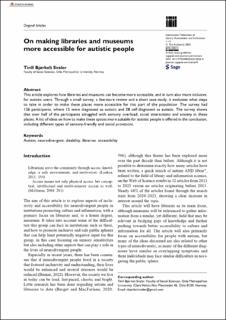| dc.contributor.author | Svaler, Tirill Bjørkeli | |
| dc.date.accessioned | 2024-02-08T06:56:24Z | |
| dc.date.available | 2024-02-08T06:56:24Z | |
| dc.date.created | 2023-11-08T12:00:21Z | |
| dc.date.issued | 2023 | |
| dc.identifier.citation | IFLA Journal. 2023, . | en_US |
| dc.identifier.issn | 0340-0352 | |
| dc.identifier.uri | https://hdl.handle.net/11250/3116268 | |
| dc.description.abstract | This article explores how libraries and museums can become more accessible, and in turn also more inclusive,
for autistic users. Through a small survey, a literature review and a short case study, it evaluates what steps
to take in order to make these places more accessible for this part of the population. The survey had
126 participants, where 12 were diagnosed as autistic and 28 self-diagnosed as autistic. The survey shows
that over half of the participants struggled with sensory overload, social interactions and anxiety in these
places. A list of ideas on how to make these spaces more suitable for autistic people is offered in the conclusion,
including different types of sensory-friendly and social provisions. | en_US |
| dc.language.iso | eng | en_US |
| dc.rights | Navngivelse 4.0 Internasjonal | * |
| dc.rights.uri | http://creativecommons.org/licenses/by/4.0/deed.no | * |
| dc.title | On making libraries and museums more accessible for autistic people | en_US |
| dc.type | Peer reviewed | en_US |
| dc.type | Journal article | en_US |
| dc.description.version | publishedVersion | en_US |
| cristin.ispublished | true | |
| cristin.fulltext | original | |
| cristin.qualitycode | 1 | |
| dc.identifier.doi | 10.1177/03400352231202516 | |
| dc.identifier.cristin | 2193850 | |
| dc.source.journal | IFLA Journal | en_US |
| dc.source.pagenumber | 0 | en_US |

